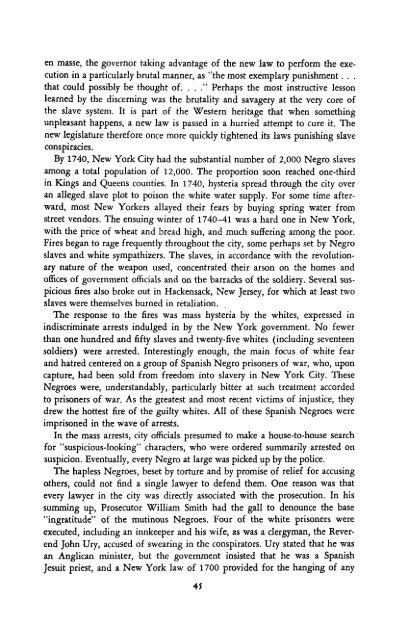Conceived in Liberty Volume 2 - Ludwig von Mises Institute
Conceived in Liberty Volume 2 - Ludwig von Mises Institute
Conceived in Liberty Volume 2 - Ludwig von Mises Institute
Create successful ePaper yourself
Turn your PDF publications into a flip-book with our unique Google optimized e-Paper software.
en masse, the governor tak<strong>in</strong>g advantage of the new law to perform the execution<br />
<strong>in</strong> a particularly brutal manner, as "the most exemplary punishment. . .<br />
that could possibly be thought of. . . ." Perhaps the most <strong>in</strong>structive lesson<br />
learned by the discern<strong>in</strong>g was the brutality and savagery at the very core of<br />
the slave system. It is part of the Western heritage that when someth<strong>in</strong>g<br />
unpleasant happens, a new law is passed <strong>in</strong> a hurried attempt to cure it. The<br />
new legislature therefore once more quickly tightened its laws punish<strong>in</strong>g slave<br />
conspiracies.<br />
By 1740, New York City had the substantial number of 2,000 Negro slaves<br />
among a total population of 12,000. The proportion soon reached one-third<br />
<strong>in</strong> K<strong>in</strong>gs and Queens counties. In 1740, hysteria spread through the city over<br />
an alleged slave plot to poison the white water supply. For some time afterward,<br />
most New Yorkers allayed their fears by buy<strong>in</strong>g spr<strong>in</strong>g water from<br />
street vendors. The ensu<strong>in</strong>g w<strong>in</strong>ter of 1740-41 was a hard one <strong>in</strong> New York,<br />
with the price of wheat and bread high, and much suffer<strong>in</strong>g among the poor.<br />
Fires began to rage frequently throughout the city, some perhaps set by Negro<br />
slaves and white sympathizers. The slaves, <strong>in</strong> accordance with the revolutionary<br />
nature of the weapon used, concentrated their arson on the homes and<br />
offices of government officials and on the barracks of the soldiery. Several suspicious<br />
fires also broke out <strong>in</strong> Hackensack, New Jersey, for which at least two<br />
slaves were themselves burned <strong>in</strong> retaliation.<br />
The response to the fires was mass hysteria by the whites, expressed <strong>in</strong><br />
<strong>in</strong>discrim<strong>in</strong>ate arrests <strong>in</strong>dulged <strong>in</strong> by the New York government. No fewer<br />
than one hundred and fifty slaves and twenty-five whites (<strong>in</strong>clud<strong>in</strong>g seventeen<br />
soldiers) were arrested. Interest<strong>in</strong>gly enough, the ma<strong>in</strong> focus of white fear<br />
and hatred centered on a group of Spanish Negro prisoners of war, who, upon<br />
capture, had been sold from freedom <strong>in</strong>to slavery <strong>in</strong> New York City. These<br />
Negroes were, understandably, particularly bitter at such treatment accorded<br />
to prisoners of war. As the greatest and most recent victims of <strong>in</strong>justice, they<br />
drew the hottest fire of the guilty whites. All of these Spanish Negroes were<br />
imprisoned <strong>in</strong> the wave of arrests.<br />
In the mass arrests, city officials presumed to make a house-to-house search<br />
for "suspicious-look<strong>in</strong>g" characters, who were ordered summarily arrested on<br />
suspicion. Eventually, every Negro at large was picked up by the police.<br />
The hapless Negroes, beset by torture and by promise of relief for accus<strong>in</strong>g<br />
others, could not f<strong>in</strong>d a s<strong>in</strong>gle lawyer to defend them. One reason was that<br />
every lawyer <strong>in</strong> the city was directly associated with the prosecution. In his<br />
summ<strong>in</strong>g up, Prosecutor William Smith had the gall to denounce the base<br />
"<strong>in</strong>gratitude" of the mut<strong>in</strong>ous Negroes. Four of the white prisoners were<br />
executed, <strong>in</strong>clud<strong>in</strong>g an <strong>in</strong>nkeeper and his wife, as was a clergyman, the Reverend<br />
John Ury, accused of swear<strong>in</strong>g <strong>in</strong> the conspirators. Ury stated that he was<br />
an Anglican m<strong>in</strong>ister, but the government <strong>in</strong>sisted that he was a Spanish<br />
Jesuit priest, and a New York law of 1700 provided for the hang<strong>in</strong>g of any<br />
45
















